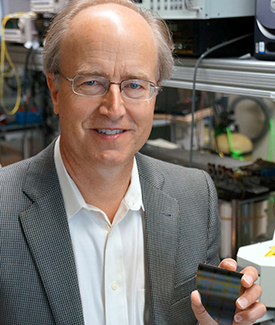
UCSB Professor John Bowers Gives 58th Annual Faculty Research Lecture
Faster. Larger capacity. Higher efficiency. These are the qualities UC Santa Barbara professor John Bowers envisions for the future of telecommunications and information processing, and an overflow crowd gathered at UCSB's Engineering Sciences Building yesterday to hear him discuss exactly that at the campus's 58th Annual Faculty Research Lecture.
In his talk, "The Promise of Silicon Photonics," Bowers, a professor of electrical and computer engineering and of materials, discussed the evolution of silicon photonics and what the future holds for this technology.
Awarded annually, the Faculty Research Lecture is considered the highest honor bestowed by the university faculty on one of its members. Bowers, an internationally renowned authority in the area of optoelectronics, was recognized not only for his outstanding teaching abilities, but also for his accomplishments as an effective collaborator and successful entrepreneur.
"I truly want to thank the faculty for this award and the opportunity to speak today," said Bowers, who also holds the Fred Kavli Chair in Nanotechnology at UCSB and is director of the campus's Institute for Energy Efficiency. A member of several high-profile organizations, such as the Institute of Electrical and Electronics Engineers, the National Academy of Engineering and the American Physical Society, he is the author of numerous journal and conference papers, as well as co-founder of several technology companies and the nonprofit Unite to Light, which aims to provide low-cost LED lighting to underserved communities around the world.
Bowers began his talk by focusing on the earliest days of telecommunications, with the invention of the electric telegraph by Samuel Morse and the subsequent trans-Atlantic telegraph cable successfully laid for the first time in 1858. All of which, he noted, came before the Civil War. Shifting to modern photonics, he pointed out advances in the technology over the decades and continuing efforts to modernize the technology. He cited research by his former students as well as that of other UCSB faculty members, including Herbert Kroemer, a professor of electrical and computer engineering, and a 2000 Nobel Laureate.
While the world continues to search for even better technologies for receiving and transmitting information, and speeds have greatly improved from the 15 minutes it took to send a message electronically from one side of the world to the other in the late 19th century, new obstacles have emerged.
Advanced technology creates more users, and allows them to utilize their devices in new and expanded ways to do more through their devices. This has contributed to growing data generation, which has, in turn, led to increased energy usage and the need for higher capacities that are beginning to outpace Moore's law, which predicts the doubling of computer chip performance (more speed and memory for about the same amount of energy) every two years. Smartphone use, Bowers said, is a chief factor behind the recent dramatic rise in data transmission, which leads to increased energy usage, and the need for even more energy to cool the massive data centers that relay information back and forth.
According to Bowers, the solution to the problems the age of Big Data present lies in photonics –– the use of light to transmit data. While photonics has been utilized since the 1960s and 1970s with the advent of lasers and fiberoptics, the next-generation technology relies on silicon photonic integrated circuitry, constructed with complementary-metal-oxide-semiconductor (CMOS) technology, where multiple photonic devices are implanted on a silicon wafer. This technology promises far more efficiency, higher capacity and better scalability at a lower cost than conventional electronics to perform the same tasks, and is one that computing giants such as Hewlett-Packard, IBM and Intel are actively pursuing.
"That's the power of having optics on the chip itself," said Bowers, of the move toward silicon photonics. "That's where I think we'll be by the year 2020."
Bowers gave much credit to UCSB and the resources and brainpower the university provides in the quest for advanced silicon photonics.
"This is a tremendous group to work in," he said. "All of us sort of live off the capabilities of everybody else."
Related Links



